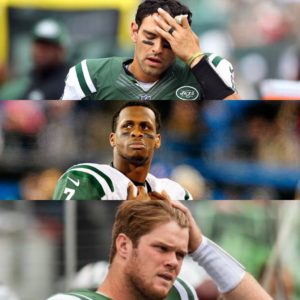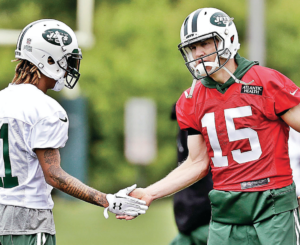Teams should not draft for need in the first round, particularly in the top half of the first round. So when perhaps the best player in the 2015 draft — Southern Cal’s Leonard Williams — the Jets were faced with an interesting decision. Williams profiled as a five-technique defensive end in a 3-4 or a 3-technique defensive tackle in a 4-3, although he’s lauded for his versatility in playing along the line. For New York, the team’s best position in terms of talent and age is 3-4 defensive end, where Muhammad Wilkerson and Sheldon Richardson ply their trade.
Last year, Pro Football Focus charted 47 3-4 defensive ends that played at least 25% of their team’s snaps. The top three were J.J Watt, Richardson, and Wilkerson. For a team that went 4-12, adding a third dominant (if Williams pans out) 3-4 defensive end seems like a luxury. But is it? What are the Jets thinking?
Can’t the Jets Just Switch To A 4-3 Defense?
Not really. Sure, Todd Bowles is famous for his versatile defensive fronts, as Rex Ryan was before him. In a 4-3, the Jets could get everyone on the field, but they’d lack a true pass-rushing 4-3 defensive end. More importantly, the Jets don’t have the personnel to play linebacker in a 4-3.
The Jets two inside linebackers, David Harris and Demario Davis, led the team in snaps last year. Switching to a 4-3 obviously means either benching one of them or switching one to outside linebacker. Harris, limited in his speed and agility even by 3-4 ILB standards, would appear to be a terrible fit for a 4-3, and benching him is unlikely given that he has more guaranteed money per year on his contract than any other inside linebacker. Davis could, perhaps, switch to outside linebacker, but who would be the other option? Calvin Pace or Quinton Coples would be far too slow to cover enough ground at that position. Frankly, in a 4-3, the Jets would have one of the worst linebacker groups in the NFL.
The Jets would be fine in nickel (4-2-5), but again, where would the pass rush come from? The farther you put two of Wilkerson, Williams, or Richardson from the center/quarterback, the less you get to take advantage of their true talents. None of them are true 4-3 pass rushing ends; all could play it, but you move away from their strengths. Williams, Wilkerson, and Richardson are all about 6-4 and 300 pounds. Last year, there were 19 players who recorded double digit sacks in the NFL. Twelve of those players weighed 260 pounds or fewer, while another three were between 260 and 280 pounds. The remaining four: two huge outside linebackers (Paul Kruger and Mario Williams), a defensive tackle (Marcell Dareus), and Watt. If the Jets switch to a 4-3, the team would probably be worse off when it comes to rushing the passer, and it’s hard to imagine the team being any better against the run.
Okay, what about a 3-4 with those three on the line?
That could work… if the Jets didn’t happen to have one of the best nose tackles in the NFL. Among 3-4 teams, Damon Harrison rated as the top nose tackle against the run by Pro-Football-Focus last year, which is where he ranked in 2013, too.
Harrison recorded a “stop” on 12.5% of his snaps last year when the opposing team ran the ball. That was the best of any defensive lineman, regardless of position or alignment, in the NFL in 2014. In 2013, Richardson ranked 2nd to Watt in this metric. Taking Harrison off the field on running downs makes no sense at all, especially when he’s about 50 pounds heavier than each of Wilkerson, Williams, and Richardson.
Okay, So Now What? Do They Trade Wilkerson?
Richardson is not going to get traded, while Wilkerson is playing out his fifth year option this year. It makes no sense for New York to trade him right now, though, given that he’s only due to count for seven million against the cap. And since the Jets could still franchise him, there’s no rush to trade him, either, at least until Williams shows that he’s as good as everyone thinks. Oh, and by the way, teams aren’t in the habit of just letting All-Pro caliber defensive ends just leave in the primes of their careers.
Okay, so Harrison has to be on the field on run plays, and the Jets probably can’t play a 4-3. So what do they do with Williams?
This was the conundrum faced by the Jets once Williams slid to the sixth pick. Do you bypass an elite talent because he’s not a need pick? Of course not! Do you remember Tony Jones and Orlando Brown? Both were above-average tackles, the position of strength for a bad Cleveland Browns team in 1995. The team was hoping to take Simeon Rice with the 4th overall pick in the ’96 draft, but the Cardinals took Rice with the 3rd pick. With the 4th pick, the franchise — now in Baltimore — selected Jonathan Ogden.
As a rookie, Ogden … played left guard for the Ravens. After the season, Baltimore traded Jones to Denver for the 58th pick in the ’97 draft. The Jets could be in a similar situation, and it wouldn’t shock me to see the team try to trade Wilkerson for a 2016 1st round pick (if not more). That’s what you call a good problem.
But What About 2015?
Again, teams shouldn’t make their draft decisions based on what will happen in the immediate future. If the Jets took Kevin White or Vic Beasley — the 7th and 8th picks and players at clearer positions of need — both would just be rotational players as rookies. And that’s what the team will do with Williams this year.
Richardson and Wilkerson generally play about 80% of the team’s defensive snaps. Perhaps that number drops to 70-75% this year: and while you don’t want to take either of them off the field, you may be able to extract even better play on a per-play basis if you give them a breather every once in a awhile. That would leave Williams around to play about 55% of snaps as a rookie, which is a pretty reasonable number. And, of course, the team could wind up having all three on the field every once in awhile, so Williams could still feature in about 2/3 of all plays.
Last year, rookie Aaron Donald played in 67% of the defensive snaps for the St. Louis Rams, despite being arguably the best defensive tackle in the NFL. And who knows what the team will do this year, with Donald, Michael Brockers, and Nick Fairley all on the defensive tackle depth chart. But that’s the point: teams need to rotate their defensive linemen, particularly the interior linemen.
So the Jets have three great five technique defensive ends. Would the team be better off with an elite edge rushing 3-4 OLB than Williams? Probably, but presumably the team’s scouting department didn’t see a player that was on the same talent level as Williams. And not reaching is the right move in that case.
When the Seahawks won the Super Bowl in 2013, the team rotated its top seven defensive linemen. In Seattle’s 4-3 defense, all seven played between 480 and 600 snaps, and that seemed to work out just fine for the team. Rotating three defensive stars (and occasionally having all three on the field) may not be the sexiest solution, but it’s the most reasonable. And there’s nothing wrong with that.









